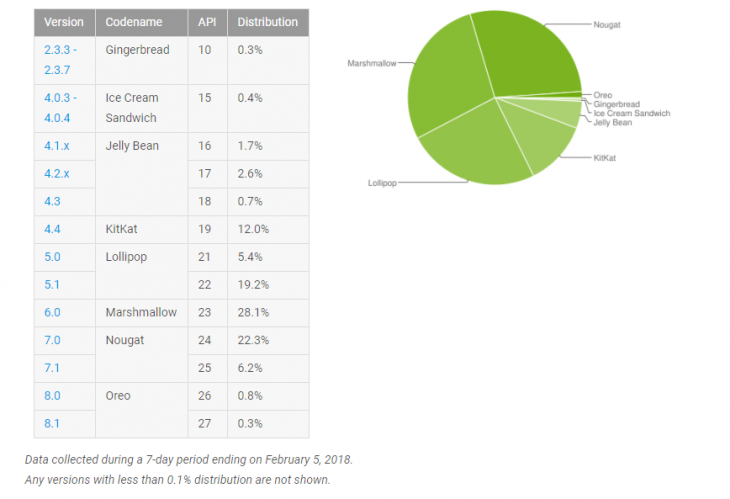
Each month when Google releases the Android distribution numbers there is often very little surprise and this month is no exception.
As expected, Oreo continues to grow, albeit slowly. Android 8.1 did increase by 50% but considering it was only 0.2% last month a 50% increase is not a great deal. Oreo 8.0 increased from 0.5% to 0.8% which is significant but it would be nice to see this increase much more and most likely will when the new 2018 phones are released in the next couple of months.
Disappointingly once again Nougat increased as well but at least that was at the expense of all of the older Android versions.
For the record, here’s how the numbers compared against last month:
| Android Version | January 2018 | February 2018 |
| Android 2.3.3 – 2.3.7 (Gingerbread) | 0.4% | 0.3% |
| Android 4.0.3 – 4.0.4 (Ice Cream Sandwich) | 0.5% | 0.4% |
| Android 4.1.x (JellyBean) | 1.9% | 1.7% |
| Android 4.2.x (JellyBean) | 2.9% | 2.6% |
| Android 4.3 (JellyBean) | 0.8% | 0.7% |
| Android 4.4 (KitKat) | 12.8% | 12.0% |
| Android 5.0 (Lollipop) | 5.7% | 5.4% |
| Android 5.1 (Lollipop) | 19.4% | 19.2% |
| Android 6.0 (Marshmallow) | 28.6% | 28.1% |
| Android 7.0 (Nougat) | 21.1% | 22.3% |
| Android 7.1 (Nougat) | 5.2% | 6.2% |
| Android 8.0 (Oreo) | 0.5% | 0.8% |
| Android 8.1 (Oreo) | 0.2 | 0.3% |
Hopefully with the introduction of Project Treble for all phones launching with Android 8.0 and above we will see manufacturers update more of their phones and those they do will hopefully receive the updates a lot faster. Time will tell but that is Google’s plan, something we hope comes to fruition.





That may quickly change after the Galaxy S9 release and the update to Oreo for the Galaxy S8…